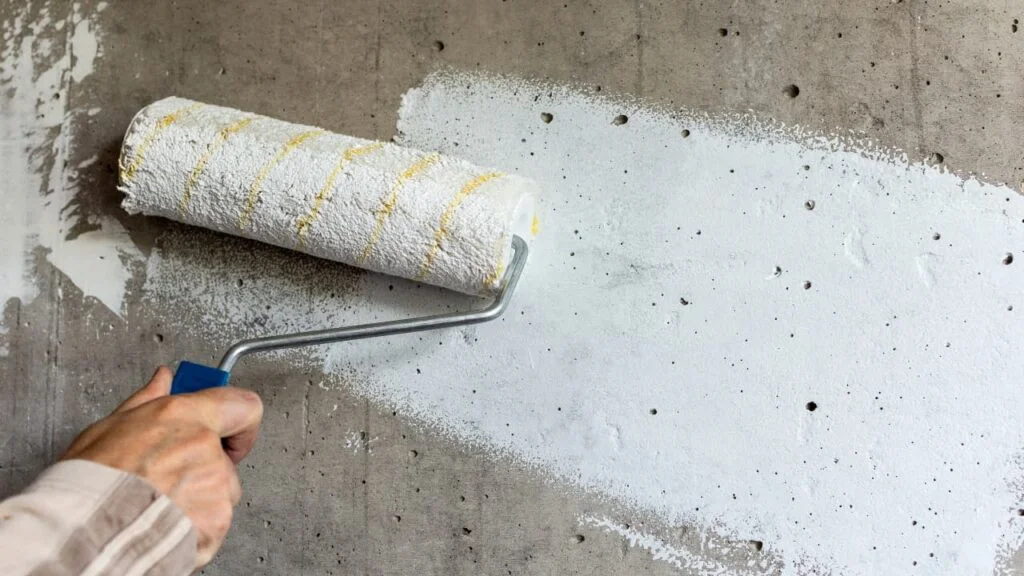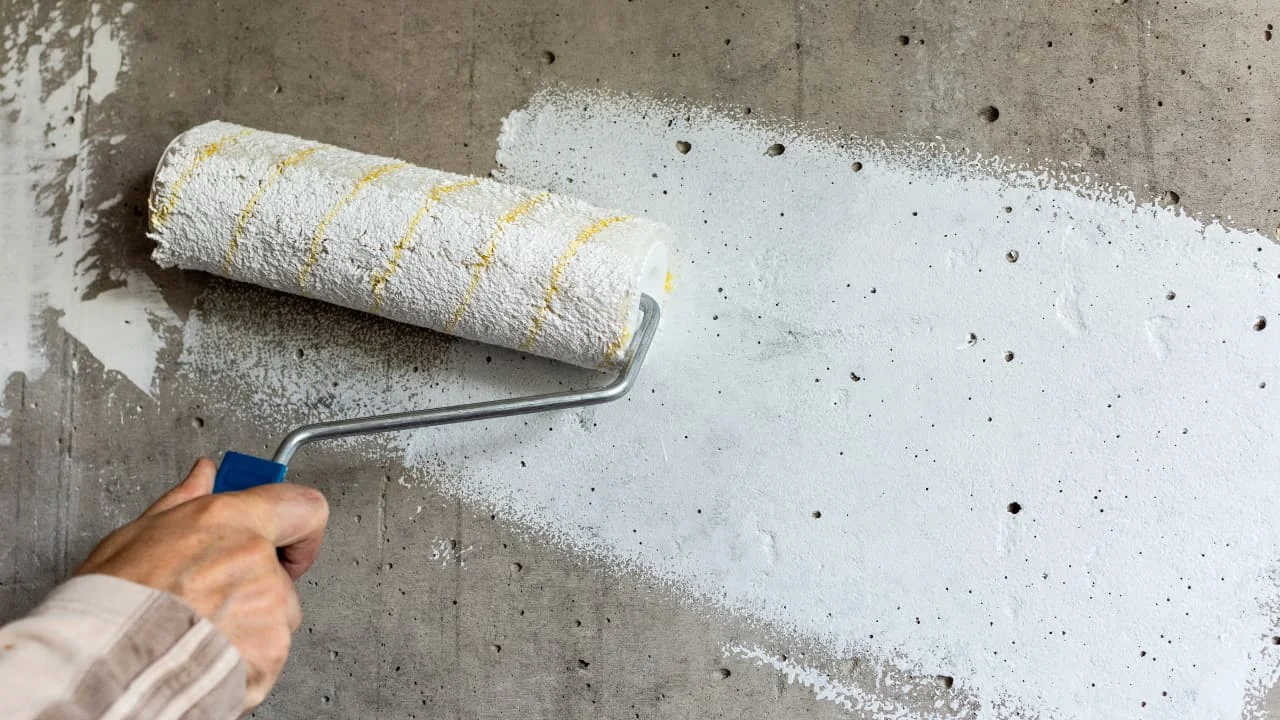Introduction: Can You Paint Concrete Like A Pro?
Do you want to transform your dull, gray concrete floor, walls, or patios into eye-catching masterpieces? You’re in the right place! In this blog post, we’ll reveal 7 game-changing techniques that can make you paint concrete surfaces like a pro.
With proper preparation and the right tools by your side, achieving a stunning and durable finish on any concrete surface is within reach.
Key Takeaways 💭
- Proper surface preparation is crucial for achieving a professional-looking concrete paint job. Thoroughly clean, repair any cracks or holes, and apply primer if necessary before painting.
- Choosing the right paint and tools can make all the difference in achieving a long-lasting finish on your concrete surfaces. Opt for specially formulated masonry or epoxy-based paints and high-quality brushes, rollers, and power washers.
- Applying thin layers of paint using a roller and brush while adding texture can help achieve a smooth, even finish that lasts longer without chipping or flaking. Working in small sections, allowing proper drying time between coats, and applying multiple coats plus sealers are also essential to attain professional results when painting concrete surfaces.
Table of Contents

Selecting The Right Paint And Tools
Proper surface preparation and choosing the right paint are crucial, but remember to also use high-quality tools such as a good quality roller and brush for even application.
Proper Surface Preparation
Proper surface preparation is crucial for a professional-looking concrete paint job. To ensure the best results, follow these steps:
- Thoroughly clean the concrete area by removing any dirt, grease, and debris.
- Use a pressure washer or power washer to eliminate embedded dirt and grime.
- Repair any cracks or holes in the concrete with a suitable filler or patching compound.
- Allow the repairs to cure according to the manufacturer’s instructions.
- Use a wire brush or paint scraper to remove loose or peeling paint from previously painted surfaces.
- Smooth out any rough edges or uneven areas with sandpaper or a putty knife.
- Eliminate any oil stains using trisodium phosphate mixed with warm water; rinse well afterward.
- If necessary, apply two coats of primer for optimal adhesion, especially when painting over an old color or working outdoors.
- Allow each coat of primer to dry completely before proceeding with the paint application process.
By carefully following these steps, you’ll create an ideal surface for your concrete paint job, ensuring long-lasting results that will look professional and stand up to wear and tear.
Choosing The Right Paint
Selecting the right paint is crucial for achieving a professional result when painting concrete surfaces. Both interior and exterior concrete require specially formulated paints that can adhere well and withstand changing weather conditions, moisture, and heavy foot traffic.
For exterior surfaces like patios, driveways, and sidewalks, opt for masonry paint or an acrylic-latex outdoor paint designed to resist fading from sunlight exposure.
Before making your final decision on which type of paint to use, it’s essential to read the manufacturer’s instructions carefully. Each product comes with specific recommendations regarding surface preparation steps (such as removing dirt or grease) as well as application techniques (like rolling or brushing).
Some may even suggest applying two coats instead of one for better coverage in challenging environments like working outdoors over an old color.
Another aspect worth considering while choosing the right paint is coordinating colors with its surroundings – whether you’re transforming a drab basement into an inviting living space or reviving your outdoor patio area with pops of vibrant hues.
Using High-Quality Tools
Investing in high-quality tools is paramount when it comes to achieving a professional paint job on concrete surfaces. Your choice of brushes, rollers, and other equipment directly impacts the final appearance and durability of your project.
Additionally, utilizing a sturdy paint scraper or putty knife can ensure that any existing loose coatings are removed effectively from the surface before applying new coats.
Also, consider using wire brushes and power washers for comprehensive cleaning of concrete floors and walls. By employing top-notch tools designed specifically for concrete painting tasks, you not only save time but also get better results that resemble the work of seasoned professionals.
Techniques For Painting Concrete Like A Pro
To achieve a professional finish when painting concrete, it is important to apply the paint in thin layers, use a roller and brush for even coverage, and add texture for added interest.
Applying Paint In Thin Layers
One of the key techniques for painting concrete like a pro is to apply paint in thin layers. This ensures that the paint dries evenly and prevents drips from forming.
When applying each layer, it’s crucial to allow proper drying time before adding another coat. This helps prevent peeling and cracking in the final finish.
Applying multiple thin coats also allows you to build up the color gradually, achieving a professional-looking result.
Using A Roller And Brush
To achieve the perfect finish when painting concrete surfaces, using a roller and brush is essential. An 18-inch roller with an extending pole can help to cover large areas quickly, resulting in a smooth finish with no uneven texture.
When using a roller, it’s important to apply paint in thin layers and work in small sections to ensure good coverage. Rolling the paint onto the surface should be done in one direction, either back and forth or up and down, depending on personal preference.
While adding texture by rolling the paint on thicker might seem like a good idea at first, this will result in an uneven surface that looks unprofessional.
Adding Texture
When painting concrete, adding texture is one technique that can help to achieve a professional finish. There are various ways to add texture while painting concrete surfaces.
One way is to use a texture roller or brush when applying the paint, creating patterns and designs on the surface of the concrete.
Using light strokes and experimenting with different textures can help you find what works best for your project. Adding texture not only adds visual interest but also serves functional purposes such as making it less slippery when wet.
It’s important to note that depending on the look you’re going for; some methods may require additional coats of paint or sealer to ensure durability.
Tips For Achieving A Professional Finish
Work in small sections, allowing each section to dry completely before moving on.
Working In Small Sections
To achieve a professional finish when painting concrete, it is important to work in small sections. This allows you to pay close attention to detail and ensures that the paint is evenly applied. Here are some tips for working in small sections:
- Use painter’s tape to mark off small areas of concrete
- Apply a thin layer of paint using a roller or brush
- Smooth out any drips or bumps before moving on to the next section
- Repeat the process until the entire surface is covered
- For large areas, divide them into smaller sections and work on them individually
- Allow each section to dry completely before moving on to the next one
Working in small sections helps you manage your time efficiently and ensures that your paint job is neat and uniform. With these steps, you can paint concrete like a pro!
Allowing Proper Drying Time
Proper drying time is a crucial aspect of achieving a professional paint job on concrete surfaces. Once you have applied the first coat of paint, it’s important to allow enough time for it to dry completely before adding another layer.
This typically takes around 24 hours but can vary depending on factors such as humidity and temperature.
In addition to allowing proper drying time between coats, you should also ensure that the final coat has sufficient time to cure. This means avoiding foot traffic or heavy use of the surface for at least 72 hours after painting.
Applying Multiple Coats And Sealers
To achieve a professional finish when painting concrete, it is essential to apply multiple coats and sealers. Typically, two coats of paint are recommended for the best coverage and durability.
The first coat should be allowed to dry completely before applying the second coat.
After the final coat of paint has been applied, it’s recommended to use a concrete sealer specifically designed for concrete surfaces. A sealer will help protect the painted surface from moisture damage, stains, and UV rays.
Applying a concrete sealer will also enhance the color and overall appearance of the painted area. Ensure that you follow the manufacturer’s instructions when choosing and applying sealers as they can vary significantly between products.
Conclusion
In conclusion, painting concrete like a pro is a task that requires proper preparation and the right techniques. By following the 7 game-changing techniques outlined in this article, you can achieve a professional finish on your concrete surface.
Remember to select high-quality paint and tools, work in small sections, apply multiple coats and sealers, and allow for proper drying time.
Can You Paint Concrete FAQs:
What are the benefits of painting concrete like a pro?
Painting concrete like a pro can enhance the appearance of your space and provide better protection against weather, stains, and wear over time. It’s also an affordable way to renew old or damaged surfaces without replacing them entirely.
Can any type of paint be used to paint concrete?
No, not all paints are suitable for use on concrete surfaces. You must choose a specialized formula that is designed to adhere well and withstand high-traffic areas, moisture exposure, and outdoor conditions. Epoxy coatings or acrylic-based paints are commonly used for painting concrete floors and walls.
What is the best technique for painting concrete surfaces like a pro?
The best technique for painting concrete surfaces like a pro involves proper preparation such as cleaning the surface thoroughly with water and detergent or using etching solutions to remove any existing sealer or coating from it before applying paint in multiple thin layers with brushes or rollers until achieving desired coverage without leaving bubbles or streaks behind.
Can I do my own prep work before starting to paint my concrete surface?
Yes, you can prepare your own surface before painting by removing any debris, oil stains or dirt particles using brooms/scrubbing pads/detergent solutions as per instructions provided by manufacturers of coating products which will enable you to achieve better results while also ensuring long-lasting finish on your painted surface!

